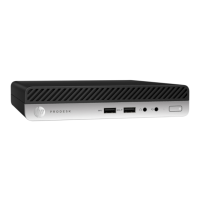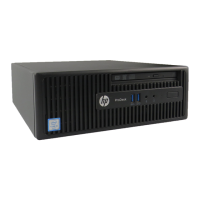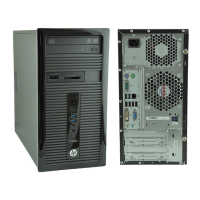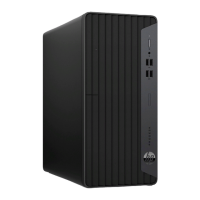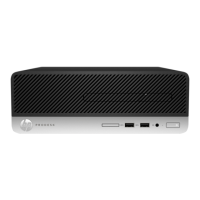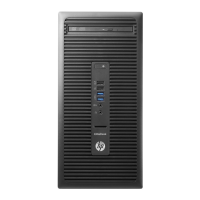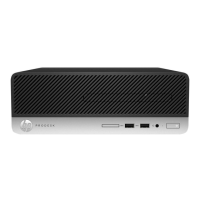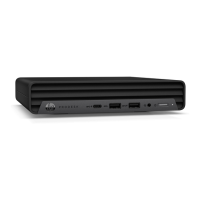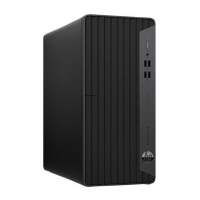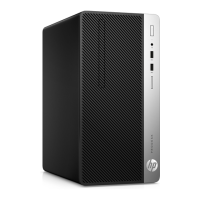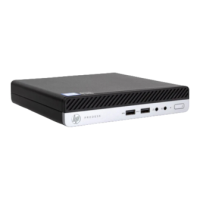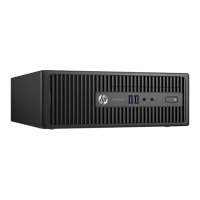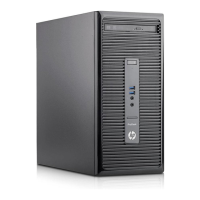
Do you have a question about the HP ProDesk 400 G2 and is the answer not in the manual?
| Tcase | 72 °C |
|---|---|
| Bus type | DMI2 |
| Stepping | C0 |
| Processor cache | 2 MB |
| Processor cores | 2 |
| Processor model | G1840 |
| System bus rate | 5 GT/s |
| Processor family | Intel® Celeron® G |
| Processor series | Intel Celeron Processor G1000 Series for Desktop |
| Processor socket | LGA 1150 (Socket H3) |
| Processor codename | Haswell |
| Processor frequency | 2.8 GHz |
| Processor cache type | L2 |
| Processor lithography | 22 nm |
| Processor manufacturer | Intel |
| Processor front side bus | - MHz |
| PCI Express slots version | 3.0 |
| Processor operating modes | 32-bit, 64-bit |
| ECC supported by processor | Yes |
| PCI Express configurations | 1x16, 2x8, 1x8+2x4 |
| Thermal Design Power (TDP) | 54, 53 W |
| Number of processors installed | 1 |
| Maximum number of PCI Express lanes | 16 |
| Memory types supported by processor | DDR3-SDRAM |
| Memory clock speeds supported by processor | 1333 MHz |
| Memory bandwidth supported by processor (max) | 21.3 GB/s |
| Maximum internal memory supported by processor | 32 GB |
| Memory slots | 2x DIMM |
| Internal memory | 4 GB |
| Memory channels | Dual-channel |
| Memory clock speed | 1600 MHz |
| Internal memory type | DDR3L-SDRAM |
| Memory layout (slots x size) | 1 x 4 GB |
| Storage media | HDD |
| Optical drive type | DVD Super Multi |
| Card reader integrated | No |
| Total storage capacity | 500 GB |
| Discrete graphics card model | Not available |
| On-board graphics card model | Intel® HD Graphics |
| Maximum on-board graphics card memory | 1.024 GB |
| On-board graphics card OpenGL version | 4.3 |
| On-board graphics card base frequency | 350 MHz |
| On-board graphics card DirectX version | 11.1 |
| On-board graphics card dynamic frequency (max) | 1050 MHz |
| Number of displays supported (on-board graphics) | 3 |
| Ethernet LAN data rates | 10, 100, 1000 Mbit/s |
| USB 2.0 ports quantity | 6 |
| USB 3.2 Gen 1 (3.1 Gen 1) Type-C ports quantity | 0 |
| Power supply | 180 W |
| Product type | PC |
| Market positioning | Business |
| Chassis type | Desktop |
| Product color | Black |
| Country of origin | China |
| Placement supported | Horizontal |
| Sustainability certificates | ENERGY STAR |
| Operating system installed | Windows 7 Professional |
| Operating system architecture | 64-bit |
| Scalability | 1S |
| Processor code | SR1VK |
| Processor ARK ID | 80800 |
| Processor package size | 37.5 x 37.5 mm |
| Supported instruction sets | SSE4.1, SSE4.2 |
| Thermal solution specification | PCG 2013C |
| Intel Secure Key Technology version | 1.00 |
| Intel Stable Image Platform Program (SIPP) version | 0.00 |
| Intel segment tagging | Enterprise, Small Business |
| Depth | 358.8 mm |
|---|---|
| Width | 165 mm |
| Height | 355 mm |
| Weight | 6500 g |
Steps to activate and configure the operating system in Windows 7.
Steps to activate and configure the operating system in Windows 8.
Process for initial setup and activation of the Windows OS.
Explanation of ESD risks and basic precautions to prevent damage.
Detailed precautions and practices to avoid ESD damage to components.
Essential safety rules to follow before cleaning any computer part.
Essential steps and precautions before starting any hardware removal.
Step-by-step instructions for installing memory modules into the system board.
Overview of the functions and capabilities of the F10 Setup utility.
Detailed steps on how to access and navigate the F10 Setup menu.
Common issues and their solutions for basic computer operation.
Troubleshooting steps for issues related to power supply and system startup.
Solutions for errors and issues related to hard disk drives.
Troubleshooting steps for issues with media card readers.
Solutions for common issues related to the video display.
Troubleshooting steps for issues with the computer's sound system.
Solutions for common issues encountered with printers.
Troubleshooting steps for input devices like keyboards and mice.
Guidance on resolving issues when installing new hardware.
Troubleshooting steps for issues connecting to the internet.
Troubleshooting steps for issues related to applications and the OS.
Troubleshooting steps for network connectivity and configuration issues.
Solutions for issues related to RAM modules and memory errors.
Troubleshooting steps for issues related to the computer's CPU.
Troubleshooting steps for issues with optical drives.
Troubleshooting steps for issues with USB flash drives.
Troubleshooting for issues with front panel devices like USB and audio.
Reference for system startup error codes and messages.
Guide to understanding diagnostic LEDs and beep codes during startup.
Procedure for clearing passwords by resetting the CMOS jumper.
Instructions for resetting the CMOS to factory default settings.
Steps to launch and execute the hardware diagnostic tests.
Overview of backup and recovery features for Windows 8/8.1.
Steps to create system backup media and restore points.
Procedure to reset the system when it is unresponsive.
Steps to recover the system using a previously created USB recovery drive.
Overview of backup and recovery features for Windows 7.
Comprehensive procedure for restoring the computer to factory state.
Steps to perform system recovery when Windows is unresponsive.
